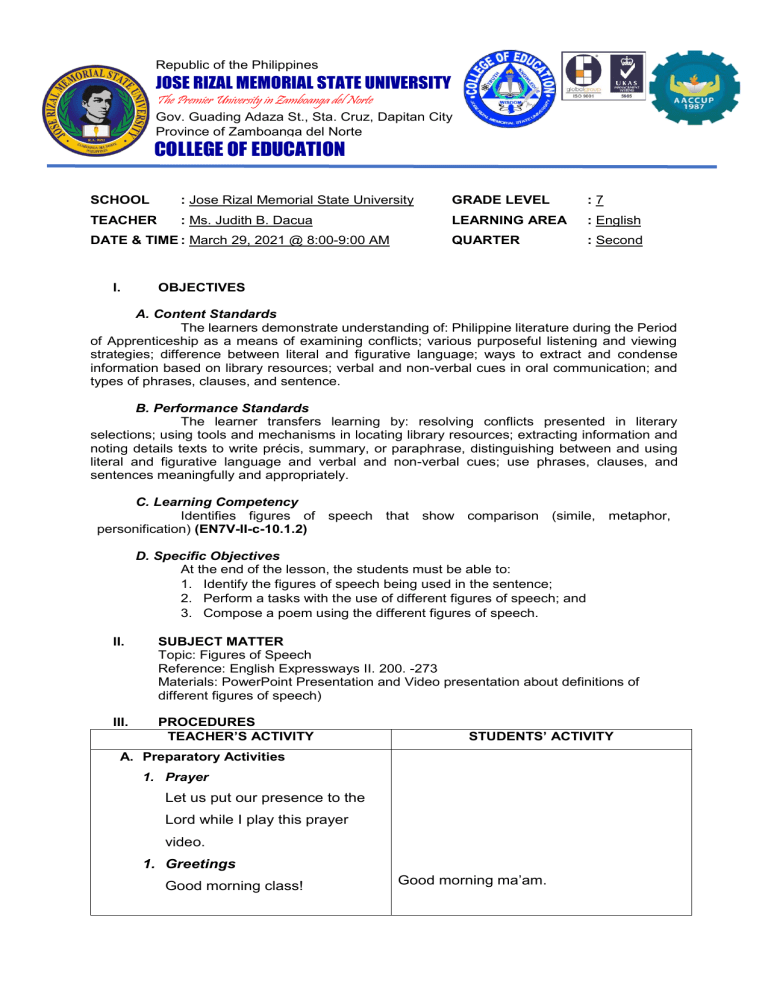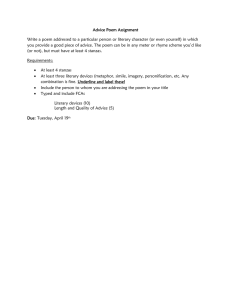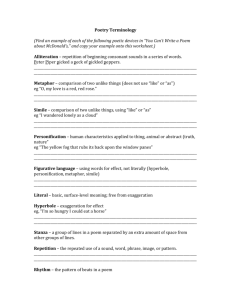
Republic of the Philippines JOSE RIZAL MEMORIAL STATE UNIVERSITY The Premier University in Zamboanga del Norte Gov. Guading Adaza St., Sta. Cruz, Dapitan City Province of Zamboanga del Norte COLLEGE OF EDUCATION SCHOOL : Jose Rizal Memorial State University GRADE LEVEL :7 TEACHER : Ms. Judith B. Dacua LEARNING AREA : English QUARTER : Second DATE & TIME : March 29, 2021 @ 8:00-9:00 AM I. OBJECTIVES A. Content Standards The learners demonstrate understanding of: Philippine literature during the Period of Apprenticeship as a means of examining conflicts; various purposeful listening and viewing strategies; difference between literal and figurative language; ways to extract and condense information based on library resources; verbal and non-verbal cues in oral communication; and types of phrases, clauses, and sentence. B. Performance Standards The learner transfers learning by: resolving conflicts presented in literary selections; using tools and mechanisms in locating library resources; extracting information and noting details texts to write précis, summary, or paraphrase, distinguishing between and using literal and figurative language and verbal and non-verbal cues; use phrases, clauses, and sentences meaningfully and appropriately. C. Learning Competency Identifies figures of speech that show comparison (simile, metaphor, personification) (EN7V-II-c-10.1.2) D. Specific Objectives At the end of the lesson, the students must be able to: 1. Identify the figures of speech being used in the sentence; 2. Perform a tasks with the use of different figures of speech; and 3. Compose a poem using the different figures of speech. II. SUBJECT MATTER Topic: Figures of Speech Reference: English Expressways II. 200. -273 Materials: PowerPoint Presentation and Video presentation about definitions of different figures of speech) III. PROCEDURES TEACHER’S ACTIVITY STUDENTS’ ACTIVITY A. Preparatory Activities 1. Prayer Let us put our presence to the Lord while I play this prayer video. 1. Greetings Good morning class! Good morning ma’am. TEACHER’S ACTIVITY STUDENTS’ ACTIVITY How are you today? That’s great. It’s good to know We are pretty good Ma’am. you are alright. 2. Class Rules Before we proceed to our discussion, what are you going to do when your teacher is talking here in front? Listen attentively ma’am. Very good. If you have questions, clarifications or you want to answer, what are you going to do? Click the raise hand button ma’am. What will you do if we have an activity? Participate in every activity. Very well. So the rules are all set. Are we all clear? Yes, Ma’am. B. Establishing Purpose for the Lesson/Motivation Look deep into the box, Cause 3-words-search will be your task. All are poetic devices; These gives beauty and rhythm to literary pieces. Before we discuss or tackle our topic for today, let us try to guess our new lesson through this short poem. Let us read it and play the game right after. I will the read the poem by line and repeat after me. Comparing is the use of second and first; One uses “as” and “like,” while the other won’t use these words. And in the third, attachment of human traits could be found, With inanimate objects which makes you astound. S I M I L E P S N B A F OR D I S A M KX E R Z ME L R E K P D U ME T L C V L F J P W P S O N T MX O Y L G I N L Y U A S N C A P H O R G R MV C Z Y U WT M H J I F I C A T A U F Y P D N F R I B K F L D Q I O H S D A N TEACHERS ACTIVITY STUDENTS’ ACTIVITY Well done. So what are the words that you have found from the box? We found the words simile, metaphor and personification. What do you call these words? These are called figures of speech ma’am. C. Presentation Exactly, and this will be our lesson this morning. Before we proceed to our lesson, let us first read the objectives for today. What do you know about figures of speech? (Everybody reads the objectives) Figures of speech are one of the poetic devices that add texture and excitement to the narratives. Correct. This are the literary devices, mostly found in poems that serves as narrative techniques. D. Discussion I have a short video here which shows comparison about these 3 figures of speech. I want you to watch and listen to it attentively because I will ask you questions and you will do an activity afterwards. Now, who can give a comparison of the 3 figures of speech regarding to the video which I presented? (Students’ watch the video) (Answers may vary) E. Developing Mastery And now I have 3 sentences here which I wanted you to identify what figure of speech is being use and I want you also to elaborate your answer. I will give you two minutes to prepare and write your answer on a piece of paper because I will call random students to read their answers afterwards. 1. The internet is like the window to the world. 2. Tom’s eyes were ice as he stared at her. 3. The shadow of the moon danced on the lake. Sentence 1 The internet is compared into a window. Simile compares two unrelated things, persons, places and concepts and is marked by using “as” and “like.” Sentence 2 The sentenced described the subject as ice. This is a metaphor ma’am. Metaphor is a comparison of two objects with the intent of giving clearer meaning to one of them. Sentence 3 It is personification because personifications are phrases that attach human traits and characteristics with inanimate objects. TEACHER’S ACTIVITY STUDENTS’ ACTIVITY F. Generalization Who can enumerate figures of speech being selected that shows comparison? The different figures of speech we have discussed ma’am are simile, metaphor and personification. Simile is a comparison of two unrelated things with use of words “like” or “as”. Metaphor is a stronger and direct comparison of two unlike things or ideas. Not using the words “like” or “as”. Personification gives human qualities to nonliving things or ideas. Exactly. Are these important to literature? Why is it so? Yes, ma’am. It is important because it adds rhythm and beauty to it, especially in poems. It is important because it helps us to be creative in writing literary piece and it rips the imagination of the readers. Brilliant ideas. G. Application Now, I want you to perform a song number which has the figures of speech that we have discussed and after that explain what and how it is being used from the song. You could sing only one song as long as these 3 figures of speech are present and could be 3 different songs as well as long as you could show us the 3 figures of speech. You are just going to sing the stanza class that has these figurative languages, Okay? I will give you 3 minutes to prepare. Well done. Do you have any questions or clarifications about our topic? None ma’am. That’s great. Now let’s have our evaluation.. IV. Evaluation Direction: Compose a 2-3 stanza poem, any theme you like. Use the 3 figures of speech and write it in a 1 whole sheet of paper. Just took a picture of your work afterwards and send it to me thru messenger right away. But before I will dismiss this class, read first the rubrics on how will I grade you base on your work. Points Criteria 9-10 4-8 1-3 Cohesiveness Rhythm Creativity The poem goes The poem The poem does perfectly together. somewhat goes not go together. There is unity together but needs The poems lines between lines and more and stanzas sway stanzas, which cohesiveness. The from the topic or connect to the poem’s lines and title they’ve topic or title stanzas chosen. they’ve chosen. sometimes sway from the topic or title they’ve chosen. The poem uses The poem The poem does rhythm sometimes uses not have any throughout, which rhythm but may noticeable benefits the poetic waver in a way rhythm. tone. that distracts the reader and negatively affects the tone. The poem uses The poem uses 1 The poem does figures of speech or 2 figures of not use unique to describe speech to describe figures of speech. situations, situations, objects, objects, and and people. people.



